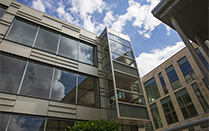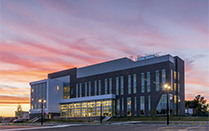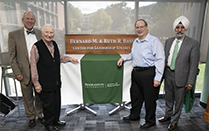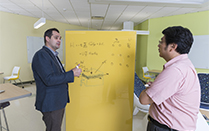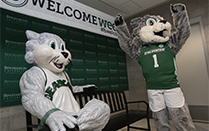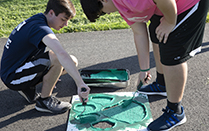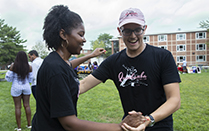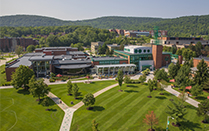Information Technology Services activities
Information Technology Services (ITS) worked this past quarter to complete upgrades to the technical infrastructure across the University, support University partners through implementation of new software and services, and execute a successful Technology Maintenance Day.
Technology Maintenance Day
ITS held its fourth Technology Maintenance Day Wednesday, Sept. 21, when ITS staff performed preventive maintenance and critical upgrades, and deployed new or upgraded tools and services to the University’s technical infrastructure, systems and applications. Generally, preventive maintenance and critical upgrades are required to avoid security risks and/or potential loss of service. ITS regularly performs maintenance on campus systems from 5-8 a.m. Tuesdays and Thursdays. However, the extended maintenance window afforded by the maintenance days allows appropriate time to address concerns with core systems and/or technology architecture.
This particular Technology Maintenance Day was successful, and ITS staff were able to complete work that would have taken roughly three months to complete during the weekly maintenance windows. Accomplishments of the day were:
• Thirty-three servers were moved to newer infrastructure that is more redundant and provides better performance. Users will benefit from faster response times and query look-ups and less of a chance of the system going offline due to a hardware failure.
• Disk firmware updates were completed for increased security and fault tolerance.
• The Email SPAM appliance was upgraded to provide better listserv performance.
• Ten servers were moved to a new virtual infrastructure and arrays. This move increases the disk performance by over 70 percent and provides faster data retrieval, queries and application performance.
• Firmware on one of the core routers was upgraded as a preventative maintenance item.
• Fiber optic installations were completed for the storage arrays in the Technology Hub data center. The storage arrays are now on better managed fiber that is easier to trace, troubleshoot and maintain over the long-term.
Project briefing for campus
The Information Technology Services (ITS) Project Management Office (PMO) was established in 2016, tasked with developing project management standardization for ITS projects and developing an ITS Project Portfolio and an intake process to receive and evaluate incoming project requests. The PMO implemented ServiceNow as a Project Portfolio Management (PPM) tool, which helps to provide visibility and transparency to all of the projects ITS works.
Since Jan. 1, 2017, the ITS PMO has received 81 formal project requests, and 104 new projects have been added to the project portfolio.
ITS held a Project Briefing open to all students, faculty and staff Sept. 29, to share information on several key projects. View the complete ITS Project Portfolio on the ITS website.
myBinghamton is open-sourced
ITS staff developed the myBinghamton “portal” for Binghamton University. This custom User eXperience Platform (UXP) is used daily by students, faculty and staff, providing a single point of access for a variety of systems and applications at the University. ITS developers have continued to work on the application since its launch in 2015, and the software is ready to share with other institutions. ITS staff are actively conversing and collaborating with other SUNY schools that are interested in using the UXP in hopes to build a community that can help the platform continue to grow. Developers who built myBinghamton want other institutions to use the platform, learn from it and contribute to the development of updates, new features and functionality. myBinghamton code and information is available online.
Collaboration across the University
• ITS staff supported the new School of Pharmacy and Pharmaceutical Sciences with the implementation and configuration of the online testing software, Examsoft. All students in the program will be using this for exams.
• A project was completed for International Student and Scholar Services (ISSS) to automate SPAIDEN table updates after processing an EForm to collect United States residential address information for international students living off campus. When the EForm is processed, updates are automatically made to jbAddress records in the Sunapsis system. This was a manual process before; this new update will save time and remove the possibility of human error.
• A project to migrate the onsite T2 parking application to a new hosted environment was completed. ITS staff provided server migration assistance, data integration with the new system and security parameters for the data transfer and storage. This transition is a benefit to Parking Services, as the vendor will now manage the updates to the system, minimizing security vulnerabilities as well as automating some processes that were not automated before.
• ITS staff also migrated the old Campus Recreation CSI Spectrum System to a new recreation management system, Fusion. The migration to Fusion included data integration with Banner, automated feeds into the system and single sign-on integration. The new management system is customizable and has the ability to assist with sales at the Rec Center and management of Recreational Sports Leagues.
Hardware upgrades
• The networking staff in ITS worked throughout the summer to update Wi-Fi in the residential communities. Router and switch upgrades were performed and access point upgrades were completed to provide state-of-the-art Wi-Fi services to students living on campus.
• The campus network was also optimized this summer as bandwidth shaping was removed from campus internet connections.
• Executing a request from students, the networking staff installed and is piloting several outdoor test Wi-Fi units across campus. The units are located on the west side of the University Union and on the southwest corner of the Fine Arts Building facing into the Lois B. DeFleur Walkway.
Technology Support Services reorganization
In August, the Technology Support Services (TSS) area within ITS, which includes the Help Desk, Desktop Support, ResCons and the Innovations and Research Team, was reorganized to support campus needs. The reorganization goals were to build an agile and flexible technology support organization that can respond to major institutional changes and investments, meet identified technology needs across the University as outlined in the IT Strategic Plan, continue to respond to the Task Force Assessment of ITS with a focus on improved customer service, and co-locate groups and coordinate skills for better collaboration and cross training.
The following groups were created in the reorganization:
• The Client Resolution Team, bringing the Help Desk, Learning Management Support and the ResCons together under a single area to encourage consistency and the ability to share knowledge and resources.
• The Distributed Campus Technology Support Team to ensure we are providing the technology services our distributed campuses need. The manager of this area will spend time at each site to understand the needs and priorities of the unique campuses.
• The Device Support Team to support computers, printers and mobile devices in offices and in the public computing spaces across campus.
• The Innovation and Research Team to rebuild support for researchers and their technology needs, as well as take on innovative projects such as myBinghamton enhancements, the management of Makerspaces across campus and other projects.
Other completed projects
• The Innovations and Research group within Technology Support Services is now managing the STEAM Room – a Makerspace in Mountainview College.
• Created a script to update the date of matriculation in Banner. This was necessary to generate the GETA in Banner, which was previously generated in DARS.
• Implemented the SUNY General Education Transcript Addendum (GETA) in Banner due to electronic transcript delivery. This was also necessary as part of the end-of-life of the DARS server, which is where the current GETA existed. This project created a script that moves all scores from one part of the student record to another.
• Removed the retired DARs servers (DARsV, ElvisV and Doral) from the production environment and ddjusted the course end dates in Banner to add 21 days. This helps clear up some mismatches in myCourses. With the changes, the percent difference for mismatches between Banner and myCourses went from .6xx percent to .1xx percent, a significant improvement.
• Completed the HireBing Handshake implementation for the Fleishman Center.
• Extended the reserve space on our largest file server (Firestone) by 2TB.
• Created a new process to assign a semester quota for student printing in Pharos instead of the weekly updates to Pharos.
• Implemented PODS authentication in the Linux lab to allow for the transition to PODS authentication, possible use of VDI for the labs and the removal of the NIS authentication for the campus.
• Completed setup of a test Amazon Web Services instance of the main campus webserver for Communications and Marketing.
• Installed financial aid patches to support the new Excelsior Scholarship processing and reconciliation processes.
• Completed the configuration of the WSUS system for the BGM domain to allow for automatic updates of all BGM servers with full reporting.
• Added additional storage to five database servers to allow for the growing data needs of the campus.
• Moved two MS SQL database servers to a newer virtual cluster, updated their VM hardware levels and upgraded VMTools to allow for better performance.
• Upgraded Application Manager to release 9.1.3 to support the move to Banner 9.
• Set up automated process to remove older Banner log files on the Chemung server to allow for better space management.
• Officially shut down the DARs system, including three servers, saving the campus $18,583 annually.
• Implemented CAS/LDAP authentication for the Symplicity system for Services for Students with Disabilities.
